The Influence of Brand Loyalty on Consumer Buying Behavior in Myntra
VerifiedAdded on 2022/11/28
|63
|18942
|173
Dissertation
AI Summary
This dissertation investigates the influence of brand loyalty on consumer buying behavior within Myntra, a prominent Indian fashion and lifestyle e-commerce platform. The research examines the evolving landscape of the Indian fashion industry, particularly the role of e-commerce in shaping consumer preferences. The study employs both primary and secondary data collection methods, including online surveys, to assess the relationship between brand loyalty and consumer purchasing decisions. The dissertation delves into the factors that drive consumer loyalty towards Myntra, analyzes consumer behavior patterns, and identifies the impact of brand loyalty on key consumer behaviors such as purchase frequency, brand advocacy, and price sensitivity. Through statistical analysis, the study aims to provide insights into the dynamics of brand loyalty in the context of the Indian e-commerce fashion market, offering strategic recommendations for Myntra and other similar businesses to enhance consumer loyalty and optimize their marketing strategies.
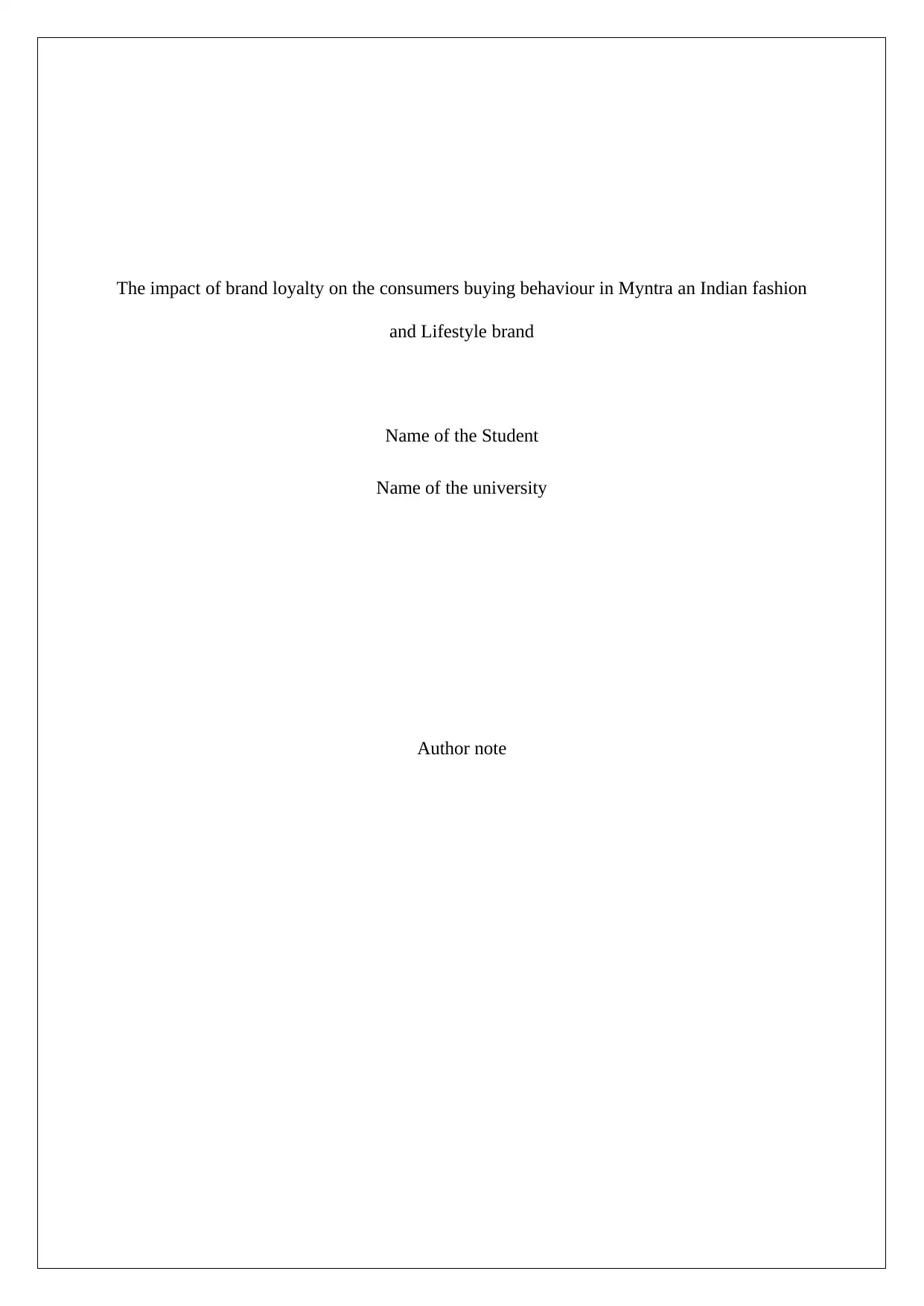
The impact of brand loyalty on the consumers buying behaviour in Myntra an Indian fashion
and Lifestyle brand
Name of the Student
Name of the university
Author note
and Lifestyle brand
Name of the Student
Name of the university
Author note
Paraphrase This Document
Need a fresh take? Get an instant paraphrase of this document with our AI Paraphraser
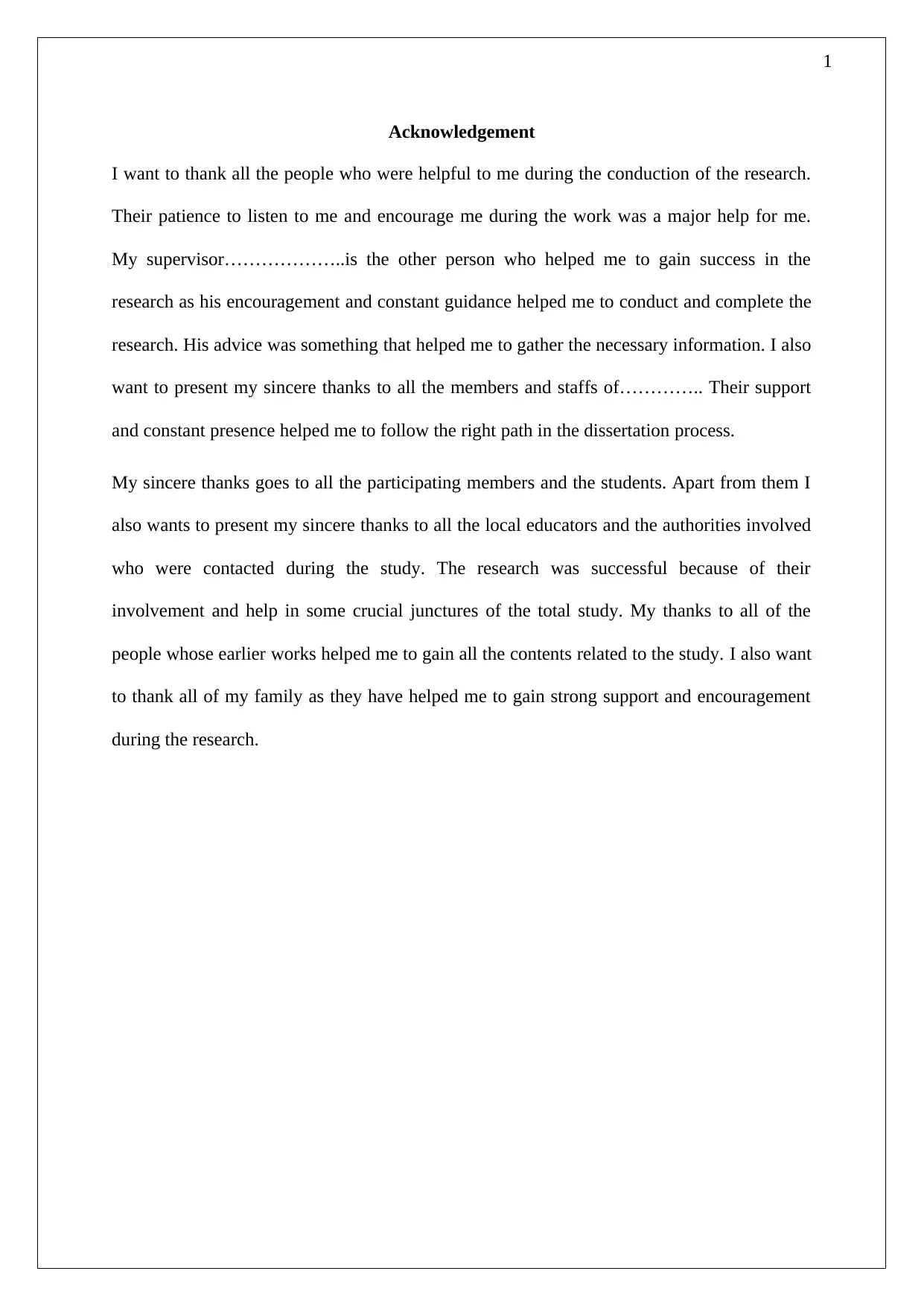
1
Acknowledgement
I want to thank all the people who were helpful to me during the conduction of the research.
Their patience to listen to me and encourage me during the work was a major help for me.
My supervisor………………..is the other person who helped me to gain success in the
research as his encouragement and constant guidance helped me to conduct and complete the
research. His advice was something that helped me to gather the necessary information. I also
want to present my sincere thanks to all the members and staffs of………….. Their support
and constant presence helped me to follow the right path in the dissertation process.
My sincere thanks goes to all the participating members and the students. Apart from them I
also wants to present my sincere thanks to all the local educators and the authorities involved
who were contacted during the study. The research was successful because of their
involvement and help in some crucial junctures of the total study. My thanks to all of the
people whose earlier works helped me to gain all the contents related to the study. I also want
to thank all of my family as they have helped me to gain strong support and encouragement
during the research.
Acknowledgement
I want to thank all the people who were helpful to me during the conduction of the research.
Their patience to listen to me and encourage me during the work was a major help for me.
My supervisor………………..is the other person who helped me to gain success in the
research as his encouragement and constant guidance helped me to conduct and complete the
research. His advice was something that helped me to gather the necessary information. I also
want to present my sincere thanks to all the members and staffs of………….. Their support
and constant presence helped me to follow the right path in the dissertation process.
My sincere thanks goes to all the participating members and the students. Apart from them I
also wants to present my sincere thanks to all the local educators and the authorities involved
who were contacted during the study. The research was successful because of their
involvement and help in some crucial junctures of the total study. My thanks to all of the
people whose earlier works helped me to gain all the contents related to the study. I also want
to thank all of my family as they have helped me to gain strong support and encouragement
during the research.
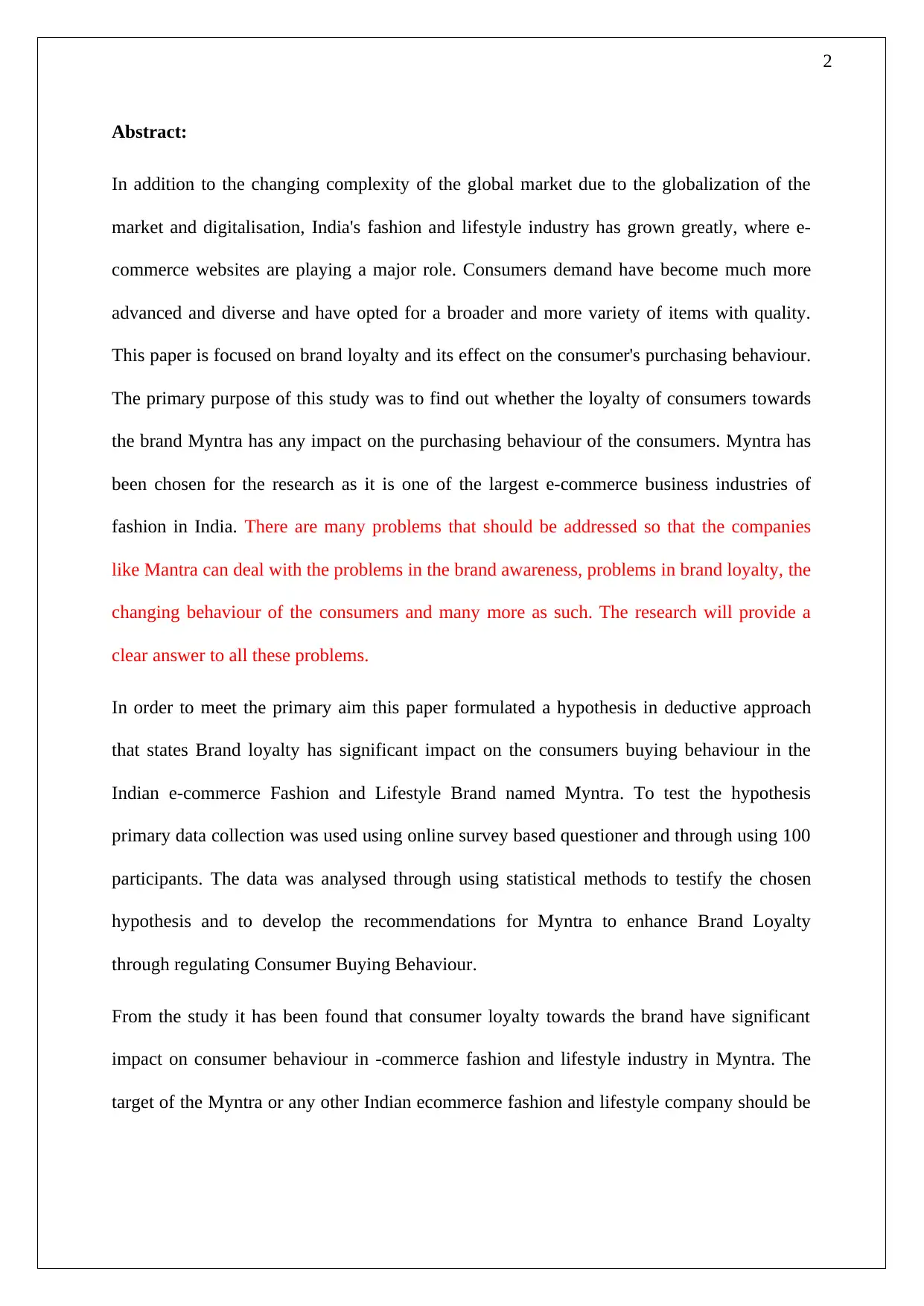
2
Abstract:
In addition to the changing complexity of the global market due to the globalization of the
market and digitalisation, India's fashion and lifestyle industry has grown greatly, where e-
commerce websites are playing a major role. Consumers demand have become much more
advanced and diverse and have opted for a broader and more variety of items with quality.
This paper is focused on brand loyalty and its effect on the consumer's purchasing behaviour.
The primary purpose of this study was to find out whether the loyalty of consumers towards
the brand Myntra has any impact on the purchasing behaviour of the consumers. Myntra has
been chosen for the research as it is one of the largest e-commerce business industries of
fashion in India. There are many problems that should be addressed so that the companies
like Mantra can deal with the problems in the brand awareness, problems in brand loyalty, the
changing behaviour of the consumers and many more as such. The research will provide a
clear answer to all these problems.
In order to meet the primary aim this paper formulated a hypothesis in deductive approach
that states Brand loyalty has significant impact on the consumers buying behaviour in the
Indian e-commerce Fashion and Lifestyle Brand named Myntra. To test the hypothesis
primary data collection was used using online survey based questioner and through using 100
participants. The data was analysed through using statistical methods to testify the chosen
hypothesis and to develop the recommendations for Myntra to enhance Brand Loyalty
through regulating Consumer Buying Behaviour.
From the study it has been found that consumer loyalty towards the brand have significant
impact on consumer behaviour in -commerce fashion and lifestyle industry in Myntra. The
target of the Myntra or any other Indian ecommerce fashion and lifestyle company should be
Abstract:
In addition to the changing complexity of the global market due to the globalization of the
market and digitalisation, India's fashion and lifestyle industry has grown greatly, where e-
commerce websites are playing a major role. Consumers demand have become much more
advanced and diverse and have opted for a broader and more variety of items with quality.
This paper is focused on brand loyalty and its effect on the consumer's purchasing behaviour.
The primary purpose of this study was to find out whether the loyalty of consumers towards
the brand Myntra has any impact on the purchasing behaviour of the consumers. Myntra has
been chosen for the research as it is one of the largest e-commerce business industries of
fashion in India. There are many problems that should be addressed so that the companies
like Mantra can deal with the problems in the brand awareness, problems in brand loyalty, the
changing behaviour of the consumers and many more as such. The research will provide a
clear answer to all these problems.
In order to meet the primary aim this paper formulated a hypothesis in deductive approach
that states Brand loyalty has significant impact on the consumers buying behaviour in the
Indian e-commerce Fashion and Lifestyle Brand named Myntra. To test the hypothesis
primary data collection was used using online survey based questioner and through using 100
participants. The data was analysed through using statistical methods to testify the chosen
hypothesis and to develop the recommendations for Myntra to enhance Brand Loyalty
through regulating Consumer Buying Behaviour.
From the study it has been found that consumer loyalty towards the brand have significant
impact on consumer behaviour in -commerce fashion and lifestyle industry in Myntra. The
target of the Myntra or any other Indian ecommerce fashion and lifestyle company should be
⊘ This is a preview!⊘
Do you want full access?
Subscribe today to unlock all pages.

Trusted by 1+ million students worldwide
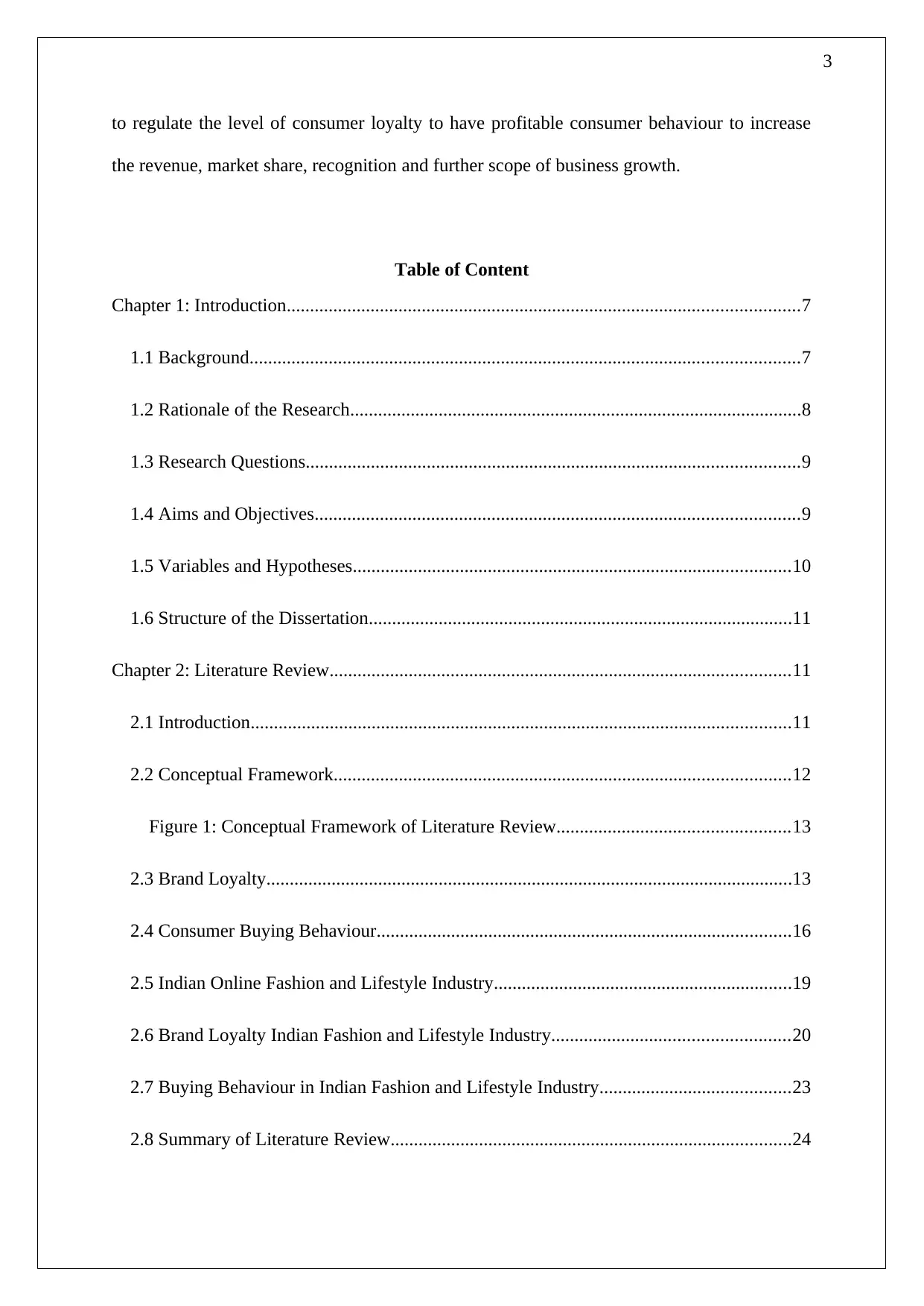
3
to regulate the level of consumer loyalty to have profitable consumer behaviour to increase
the revenue, market share, recognition and further scope of business growth.
Table of Content
Chapter 1: Introduction..............................................................................................................7
1.1 Background......................................................................................................................7
1.2 Rationale of the Research.................................................................................................8
1.3 Research Questions..........................................................................................................9
1.4 Aims and Objectives........................................................................................................9
1.5 Variables and Hypotheses..............................................................................................10
1.6 Structure of the Dissertation...........................................................................................11
Chapter 2: Literature Review...................................................................................................11
2.1 Introduction....................................................................................................................11
2.2 Conceptual Framework..................................................................................................12
Figure 1: Conceptual Framework of Literature Review..................................................13
2.3 Brand Loyalty.................................................................................................................13
2.4 Consumer Buying Behaviour.........................................................................................16
2.5 Indian Online Fashion and Lifestyle Industry................................................................19
2.6 Brand Loyalty Indian Fashion and Lifestyle Industry...................................................20
2.7 Buying Behaviour in Indian Fashion and Lifestyle Industry.........................................23
2.8 Summary of Literature Review......................................................................................24
to regulate the level of consumer loyalty to have profitable consumer behaviour to increase
the revenue, market share, recognition and further scope of business growth.
Table of Content
Chapter 1: Introduction..............................................................................................................7
1.1 Background......................................................................................................................7
1.2 Rationale of the Research.................................................................................................8
1.3 Research Questions..........................................................................................................9
1.4 Aims and Objectives........................................................................................................9
1.5 Variables and Hypotheses..............................................................................................10
1.6 Structure of the Dissertation...........................................................................................11
Chapter 2: Literature Review...................................................................................................11
2.1 Introduction....................................................................................................................11
2.2 Conceptual Framework..................................................................................................12
Figure 1: Conceptual Framework of Literature Review..................................................13
2.3 Brand Loyalty.................................................................................................................13
2.4 Consumer Buying Behaviour.........................................................................................16
2.5 Indian Online Fashion and Lifestyle Industry................................................................19
2.6 Brand Loyalty Indian Fashion and Lifestyle Industry...................................................20
2.7 Buying Behaviour in Indian Fashion and Lifestyle Industry.........................................23
2.8 Summary of Literature Review......................................................................................24
Paraphrase This Document
Need a fresh take? Get an instant paraphrase of this document with our AI Paraphraser
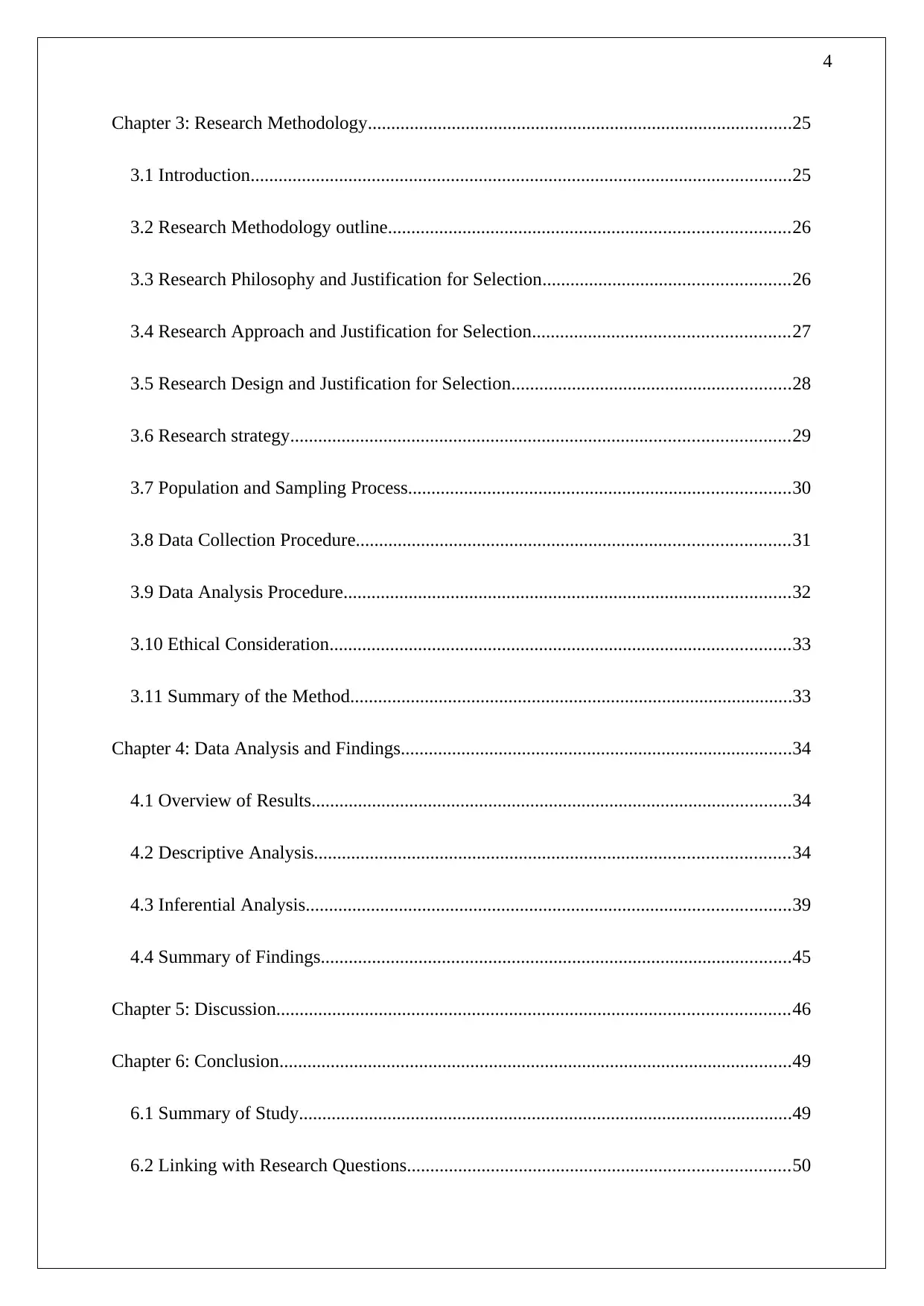
4
Chapter 3: Research Methodology...........................................................................................25
3.1 Introduction....................................................................................................................25
3.2 Research Methodology outline......................................................................................26
3.3 Research Philosophy and Justification for Selection.....................................................26
3.4 Research Approach and Justification for Selection.......................................................27
3.5 Research Design and Justification for Selection............................................................28
3.6 Research strategy...........................................................................................................29
3.7 Population and Sampling Process..................................................................................30
3.8 Data Collection Procedure.............................................................................................31
3.9 Data Analysis Procedure................................................................................................32
3.10 Ethical Consideration...................................................................................................33
3.11 Summary of the Method...............................................................................................33
Chapter 4: Data Analysis and Findings....................................................................................34
4.1 Overview of Results.......................................................................................................34
4.2 Descriptive Analysis......................................................................................................34
4.3 Inferential Analysis........................................................................................................39
4.4 Summary of Findings.....................................................................................................45
Chapter 5: Discussion..............................................................................................................46
Chapter 6: Conclusion..............................................................................................................49
6.1 Summary of Study..........................................................................................................49
6.2 Linking with Research Questions..................................................................................50
Chapter 3: Research Methodology...........................................................................................25
3.1 Introduction....................................................................................................................25
3.2 Research Methodology outline......................................................................................26
3.3 Research Philosophy and Justification for Selection.....................................................26
3.4 Research Approach and Justification for Selection.......................................................27
3.5 Research Design and Justification for Selection............................................................28
3.6 Research strategy...........................................................................................................29
3.7 Population and Sampling Process..................................................................................30
3.8 Data Collection Procedure.............................................................................................31
3.9 Data Analysis Procedure................................................................................................32
3.10 Ethical Consideration...................................................................................................33
3.11 Summary of the Method...............................................................................................33
Chapter 4: Data Analysis and Findings....................................................................................34
4.1 Overview of Results.......................................................................................................34
4.2 Descriptive Analysis......................................................................................................34
4.3 Inferential Analysis........................................................................................................39
4.4 Summary of Findings.....................................................................................................45
Chapter 5: Discussion..............................................................................................................46
Chapter 6: Conclusion..............................................................................................................49
6.1 Summary of Study..........................................................................................................49
6.2 Linking with Research Questions..................................................................................50
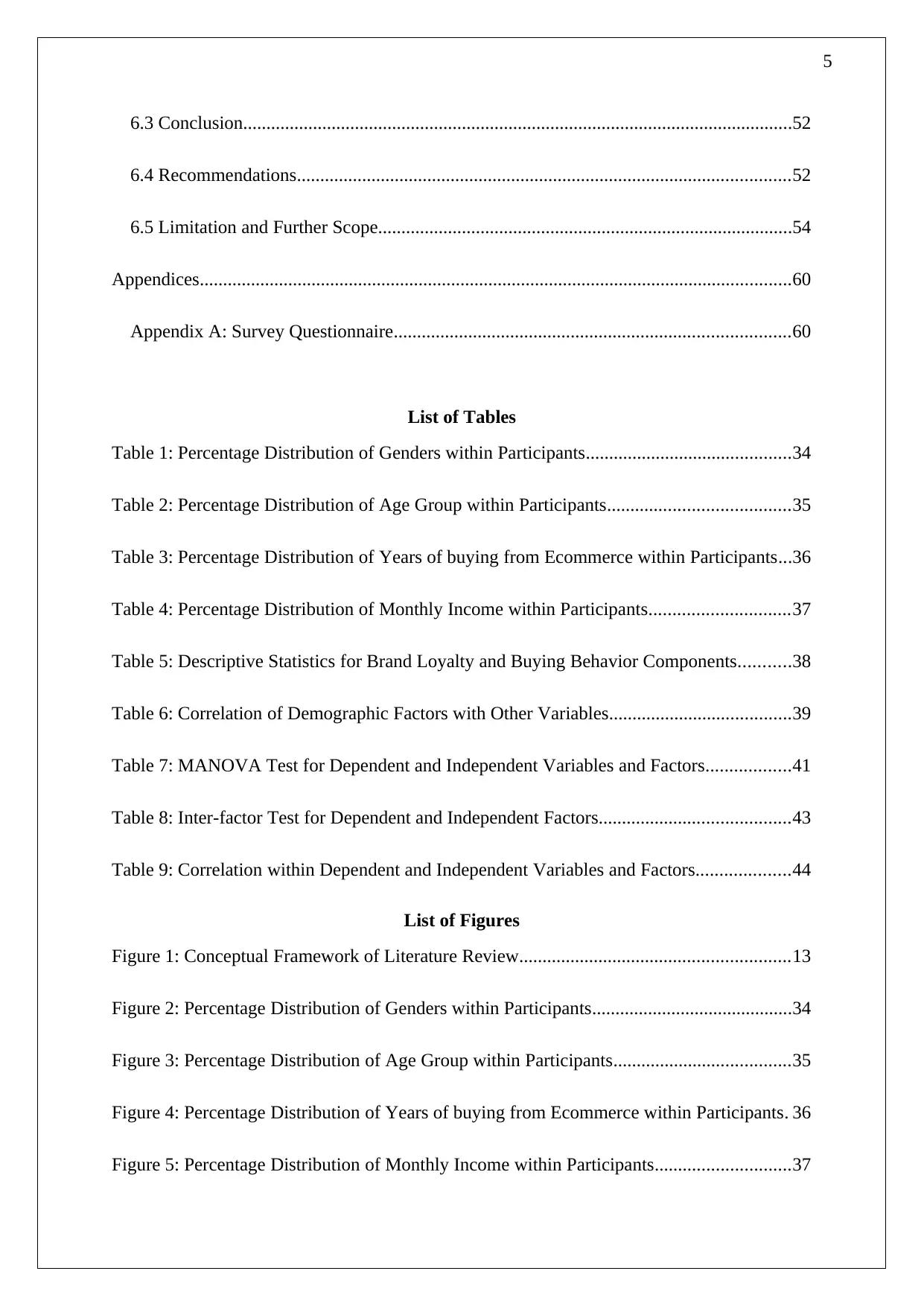
5
6.3 Conclusion......................................................................................................................52
6.4 Recommendations..........................................................................................................52
6.5 Limitation and Further Scope.........................................................................................54
Appendices...............................................................................................................................60
Appendix A: Survey Questionnaire.....................................................................................60
List of Tables
Table 1: Percentage Distribution of Genders within Participants............................................34
Table 2: Percentage Distribution of Age Group within Participants.......................................35
Table 3: Percentage Distribution of Years of buying from Ecommerce within Participants...36
Table 4: Percentage Distribution of Monthly Income within Participants..............................37
Table 5: Descriptive Statistics for Brand Loyalty and Buying Behavior Components...........38
Table 6: Correlation of Demographic Factors with Other Variables.......................................39
Table 7: MANOVA Test for Dependent and Independent Variables and Factors..................41
Table 8: Inter-factor Test for Dependent and Independent Factors.........................................43
Table 9: Correlation within Dependent and Independent Variables and Factors....................44
List of Figures
Figure 1: Conceptual Framework of Literature Review..........................................................13
Figure 2: Percentage Distribution of Genders within Participants...........................................34
Figure 3: Percentage Distribution of Age Group within Participants......................................35
Figure 4: Percentage Distribution of Years of buying from Ecommerce within Participants. 36
Figure 5: Percentage Distribution of Monthly Income within Participants.............................37
6.3 Conclusion......................................................................................................................52
6.4 Recommendations..........................................................................................................52
6.5 Limitation and Further Scope.........................................................................................54
Appendices...............................................................................................................................60
Appendix A: Survey Questionnaire.....................................................................................60
List of Tables
Table 1: Percentage Distribution of Genders within Participants............................................34
Table 2: Percentage Distribution of Age Group within Participants.......................................35
Table 3: Percentage Distribution of Years of buying from Ecommerce within Participants...36
Table 4: Percentage Distribution of Monthly Income within Participants..............................37
Table 5: Descriptive Statistics for Brand Loyalty and Buying Behavior Components...........38
Table 6: Correlation of Demographic Factors with Other Variables.......................................39
Table 7: MANOVA Test for Dependent and Independent Variables and Factors..................41
Table 8: Inter-factor Test for Dependent and Independent Factors.........................................43
Table 9: Correlation within Dependent and Independent Variables and Factors....................44
List of Figures
Figure 1: Conceptual Framework of Literature Review..........................................................13
Figure 2: Percentage Distribution of Genders within Participants...........................................34
Figure 3: Percentage Distribution of Age Group within Participants......................................35
Figure 4: Percentage Distribution of Years of buying from Ecommerce within Participants. 36
Figure 5: Percentage Distribution of Monthly Income within Participants.............................37
⊘ This is a preview!⊘
Do you want full access?
Subscribe today to unlock all pages.

Trusted by 1+ million students worldwide
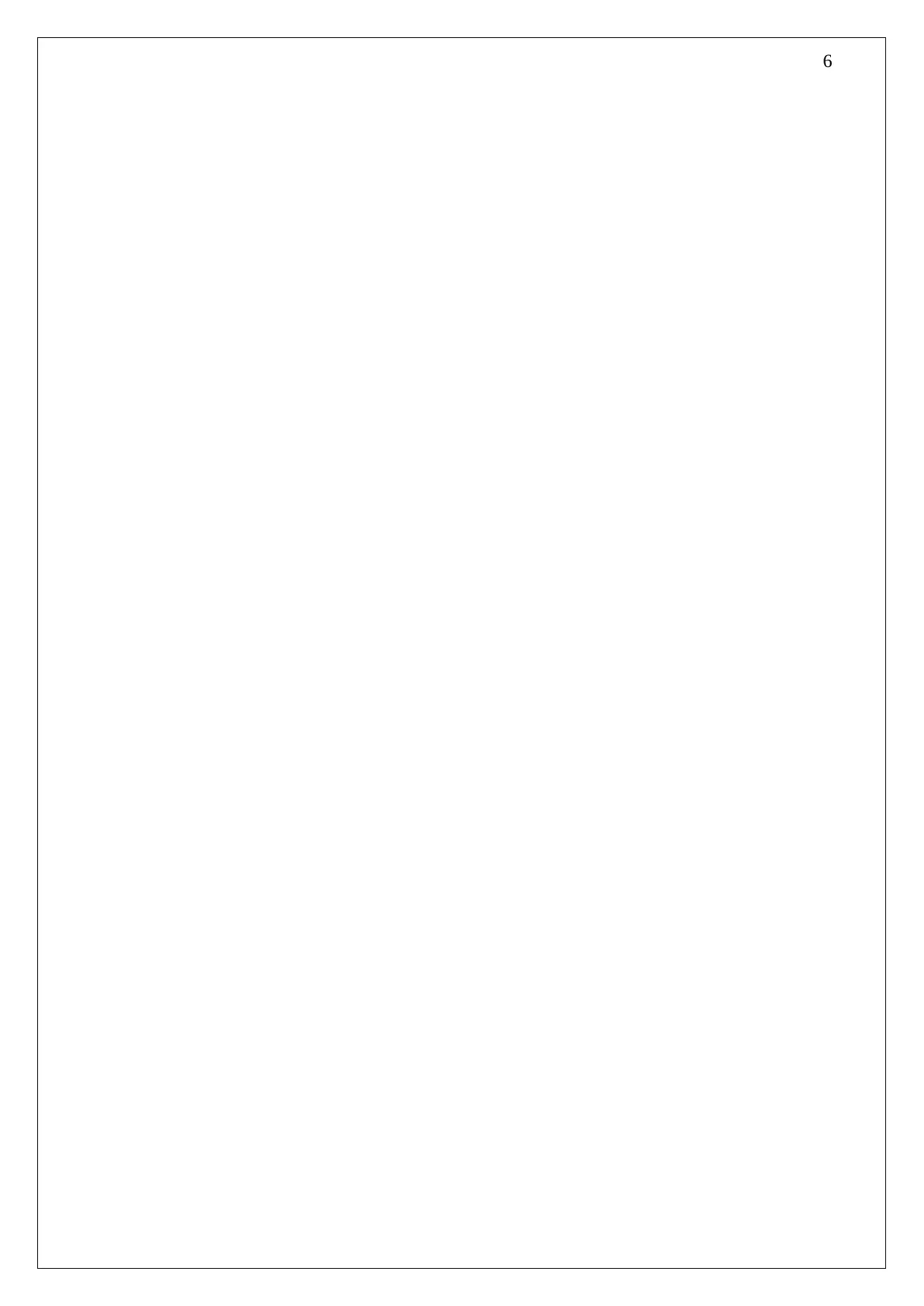
6
Paraphrase This Document
Need a fresh take? Get an instant paraphrase of this document with our AI Paraphraser
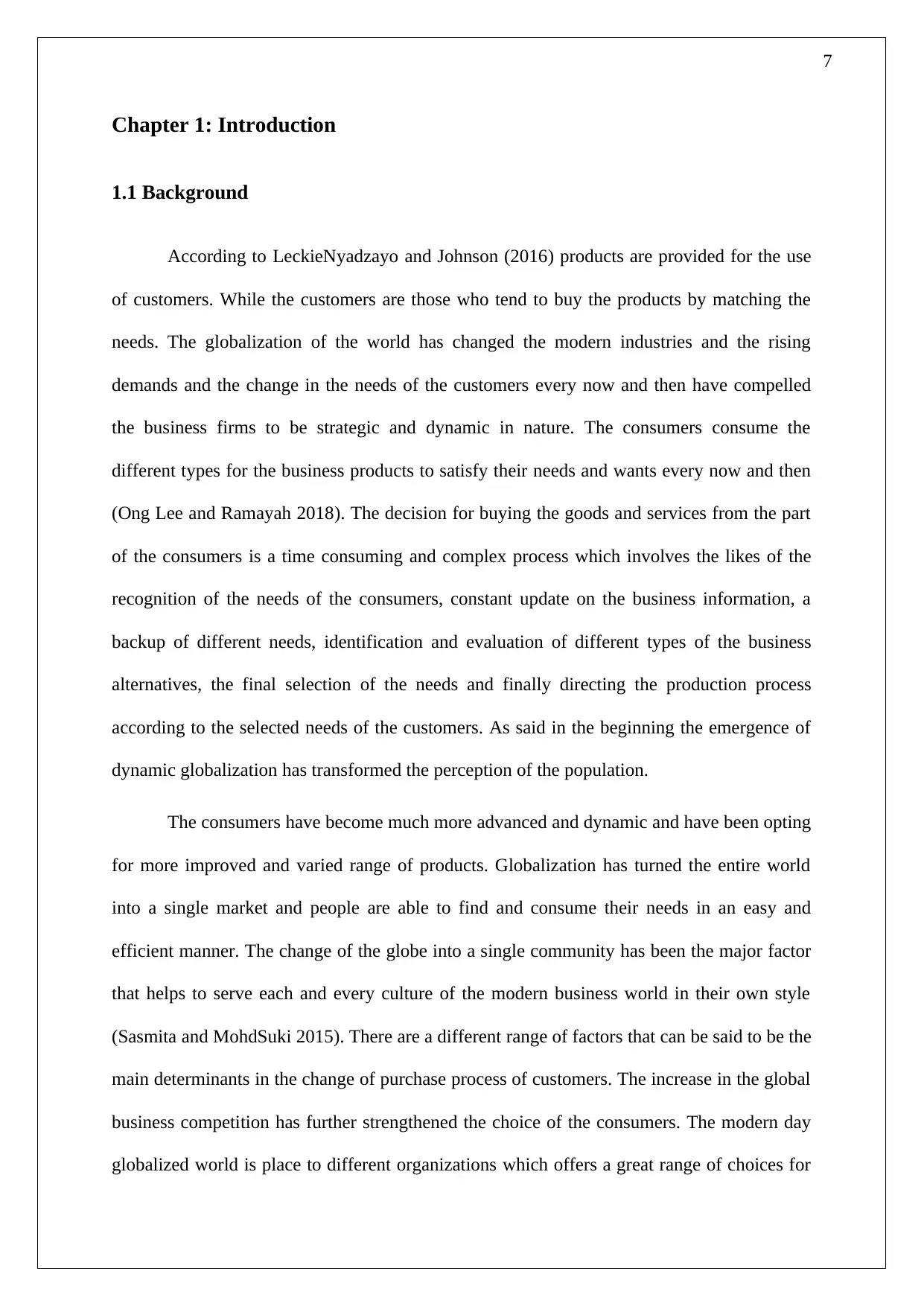
7
Chapter 1: Introduction
1.1 Background
According to LeckieNyadzayo and Johnson (2016) products are provided for the use
of customers. While the customers are those who tend to buy the products by matching the
needs. The globalization of the world has changed the modern industries and the rising
demands and the change in the needs of the customers every now and then have compelled
the business firms to be strategic and dynamic in nature. The consumers consume the
different types for the business products to satisfy their needs and wants every now and then
(Ong Lee and Ramayah 2018). The decision for buying the goods and services from the part
of the consumers is a time consuming and complex process which involves the likes of the
recognition of the needs of the consumers, constant update on the business information, a
backup of different needs, identification and evaluation of different types of the business
alternatives, the final selection of the needs and finally directing the production process
according to the selected needs of the customers. As said in the beginning the emergence of
dynamic globalization has transformed the perception of the population.
The consumers have become much more advanced and dynamic and have been opting
for more improved and varied range of products. Globalization has turned the entire world
into a single market and people are able to find and consume their needs in an easy and
efficient manner. The change of the globe into a single community has been the major factor
that helps to serve each and every culture of the modern business world in their own style
(Sasmita and MohdSuki 2015). There are a different range of factors that can be said to be the
main determinants in the change of purchase process of customers. The increase in the global
business competition has further strengthened the choice of the consumers. The modern day
globalized world is place to different organizations which offers a great range of choices for
Chapter 1: Introduction
1.1 Background
According to LeckieNyadzayo and Johnson (2016) products are provided for the use
of customers. While the customers are those who tend to buy the products by matching the
needs. The globalization of the world has changed the modern industries and the rising
demands and the change in the needs of the customers every now and then have compelled
the business firms to be strategic and dynamic in nature. The consumers consume the
different types for the business products to satisfy their needs and wants every now and then
(Ong Lee and Ramayah 2018). The decision for buying the goods and services from the part
of the consumers is a time consuming and complex process which involves the likes of the
recognition of the needs of the consumers, constant update on the business information, a
backup of different needs, identification and evaluation of different types of the business
alternatives, the final selection of the needs and finally directing the production process
according to the selected needs of the customers. As said in the beginning the emergence of
dynamic globalization has transformed the perception of the population.
The consumers have become much more advanced and dynamic and have been opting
for more improved and varied range of products. Globalization has turned the entire world
into a single market and people are able to find and consume their needs in an easy and
efficient manner. The change of the globe into a single community has been the major factor
that helps to serve each and every culture of the modern business world in their own style
(Sasmita and MohdSuki 2015). There are a different range of factors that can be said to be the
main determinants in the change of purchase process of customers. The increase in the global
business competition has further strengthened the choice of the consumers. The modern day
globalized world is place to different organizations which offers a great range of choices for
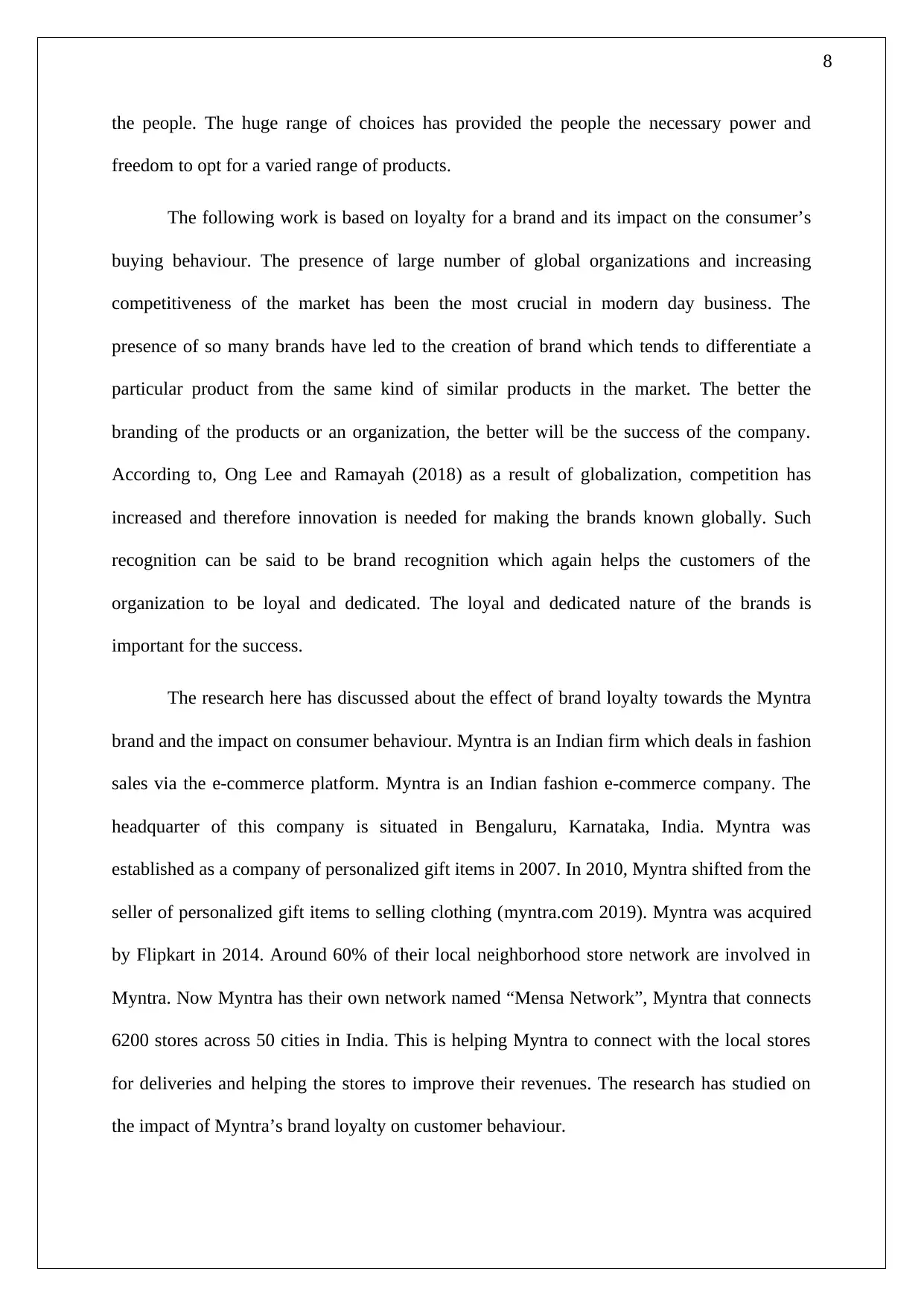
8
the people. The huge range of choices has provided the people the necessary power and
freedom to opt for a varied range of products.
The following work is based on loyalty for a brand and its impact on the consumer’s
buying behaviour. The presence of large number of global organizations and increasing
competitiveness of the market has been the most crucial in modern day business. The
presence of so many brands have led to the creation of brand which tends to differentiate a
particular product from the same kind of similar products in the market. The better the
branding of the products or an organization, the better will be the success of the company.
According to, Ong Lee and Ramayah (2018) as a result of globalization, competition has
increased and therefore innovation is needed for making the brands known globally. Such
recognition can be said to be brand recognition which again helps the customers of the
organization to be loyal and dedicated. The loyal and dedicated nature of the brands is
important for the success.
The research here has discussed about the effect of brand loyalty towards the Myntra
brand and the impact on consumer behaviour. Myntra is an Indian firm which deals in fashion
sales via the e-commerce platform. Myntra is an Indian fashion e-commerce company. The
headquarter of this company is situated in Bengaluru, Karnataka, India. Myntra was
established as a company of personalized gift items in 2007. In 2010, Myntra shifted from the
seller of personalized gift items to selling clothing (myntra.com 2019). Myntra was acquired
by Flipkart in 2014. Around 60% of their local neighborhood store network are involved in
Myntra. Now Myntra has their own network named “Mensa Network”, Myntra that connects
6200 stores across 50 cities in India. This is helping Myntra to connect with the local stores
for deliveries and helping the stores to improve their revenues. The research has studied on
the impact of Myntra’s brand loyalty on customer behaviour.
the people. The huge range of choices has provided the people the necessary power and
freedom to opt for a varied range of products.
The following work is based on loyalty for a brand and its impact on the consumer’s
buying behaviour. The presence of large number of global organizations and increasing
competitiveness of the market has been the most crucial in modern day business. The
presence of so many brands have led to the creation of brand which tends to differentiate a
particular product from the same kind of similar products in the market. The better the
branding of the products or an organization, the better will be the success of the company.
According to, Ong Lee and Ramayah (2018) as a result of globalization, competition has
increased and therefore innovation is needed for making the brands known globally. Such
recognition can be said to be brand recognition which again helps the customers of the
organization to be loyal and dedicated. The loyal and dedicated nature of the brands is
important for the success.
The research here has discussed about the effect of brand loyalty towards the Myntra
brand and the impact on consumer behaviour. Myntra is an Indian firm which deals in fashion
sales via the e-commerce platform. Myntra is an Indian fashion e-commerce company. The
headquarter of this company is situated in Bengaluru, Karnataka, India. Myntra was
established as a company of personalized gift items in 2007. In 2010, Myntra shifted from the
seller of personalized gift items to selling clothing (myntra.com 2019). Myntra was acquired
by Flipkart in 2014. Around 60% of their local neighborhood store network are involved in
Myntra. Now Myntra has their own network named “Mensa Network”, Myntra that connects
6200 stores across 50 cities in India. This is helping Myntra to connect with the local stores
for deliveries and helping the stores to improve their revenues. The research has studied on
the impact of Myntra’s brand loyalty on customer behaviour.
⊘ This is a preview!⊘
Do you want full access?
Subscribe today to unlock all pages.

Trusted by 1+ million students worldwide
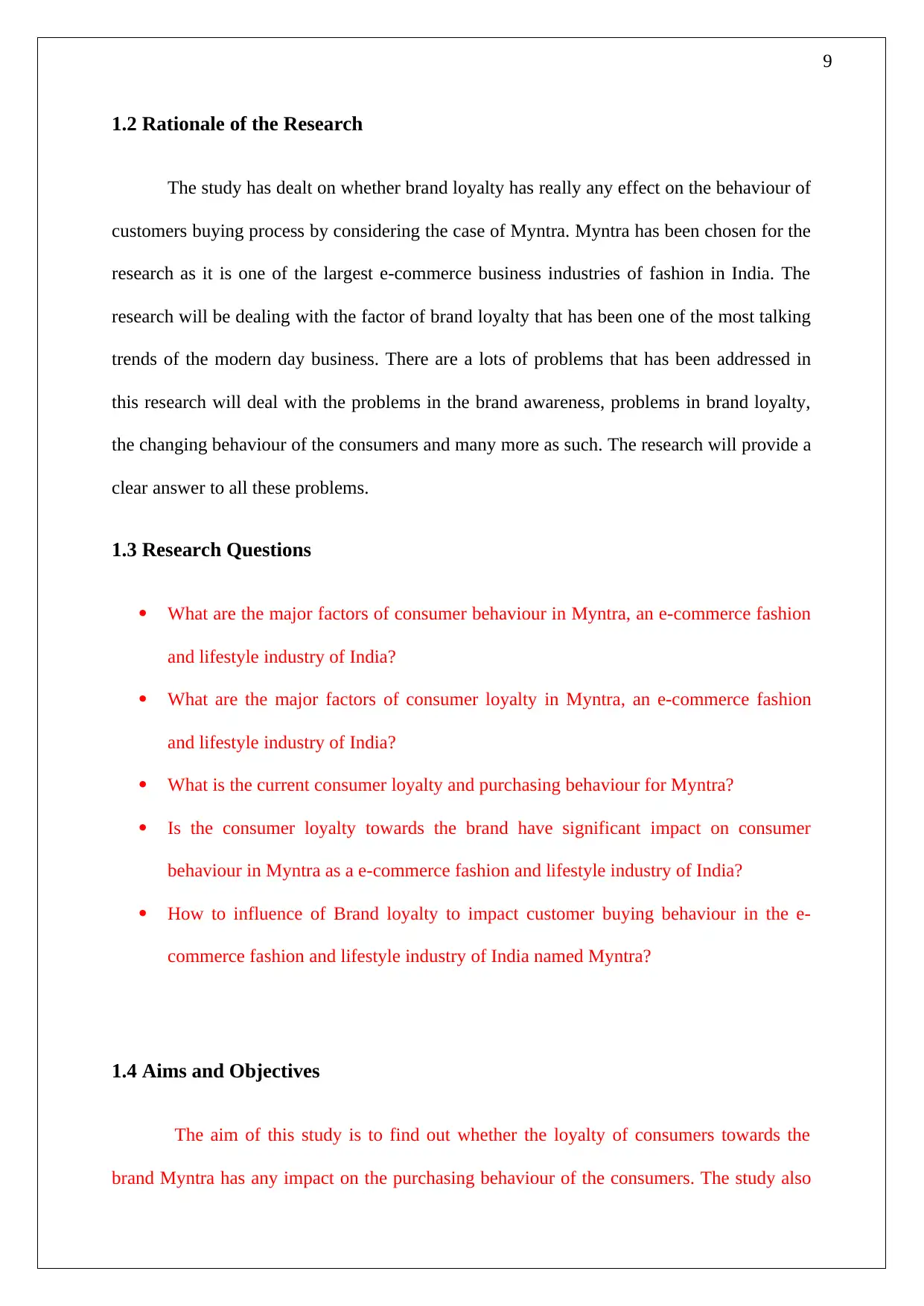
9
1.2 Rationale of the Research
The study has dealt on whether brand loyalty has really any effect on the behaviour of
customers buying process by considering the case of Myntra. Myntra has been chosen for the
research as it is one of the largest e-commerce business industries of fashion in India. The
research will be dealing with the factor of brand loyalty that has been one of the most talking
trends of the modern day business. There are a lots of problems that has been addressed in
this research will deal with the problems in the brand awareness, problems in brand loyalty,
the changing behaviour of the consumers and many more as such. The research will provide a
clear answer to all these problems.
1.3 Research Questions
What are the major factors of consumer behaviour in Myntra, an e-commerce fashion
and lifestyle industry of India?
What are the major factors of consumer loyalty in Myntra, an e-commerce fashion
and lifestyle industry of India?
What is the current consumer loyalty and purchasing behaviour for Myntra?
Is the consumer loyalty towards the brand have significant impact on consumer
behaviour in Myntra as a e-commerce fashion and lifestyle industry of India?
How to influence of Brand loyalty to impact customer buying behaviour in the e-
commerce fashion and lifestyle industry of India named Myntra?
1.4 Aims and Objectives
The aim of this study is to find out whether the loyalty of consumers towards the
brand Myntra has any impact on the purchasing behaviour of the consumers. The study also
1.2 Rationale of the Research
The study has dealt on whether brand loyalty has really any effect on the behaviour of
customers buying process by considering the case of Myntra. Myntra has been chosen for the
research as it is one of the largest e-commerce business industries of fashion in India. The
research will be dealing with the factor of brand loyalty that has been one of the most talking
trends of the modern day business. There are a lots of problems that has been addressed in
this research will deal with the problems in the brand awareness, problems in brand loyalty,
the changing behaviour of the consumers and many more as such. The research will provide a
clear answer to all these problems.
1.3 Research Questions
What are the major factors of consumer behaviour in Myntra, an e-commerce fashion
and lifestyle industry of India?
What are the major factors of consumer loyalty in Myntra, an e-commerce fashion
and lifestyle industry of India?
What is the current consumer loyalty and purchasing behaviour for Myntra?
Is the consumer loyalty towards the brand have significant impact on consumer
behaviour in Myntra as a e-commerce fashion and lifestyle industry of India?
How to influence of Brand loyalty to impact customer buying behaviour in the e-
commerce fashion and lifestyle industry of India named Myntra?
1.4 Aims and Objectives
The aim of this study is to find out whether the loyalty of consumers towards the
brand Myntra has any impact on the purchasing behaviour of the consumers. The study also
Paraphrase This Document
Need a fresh take? Get an instant paraphrase of this document with our AI Paraphraser
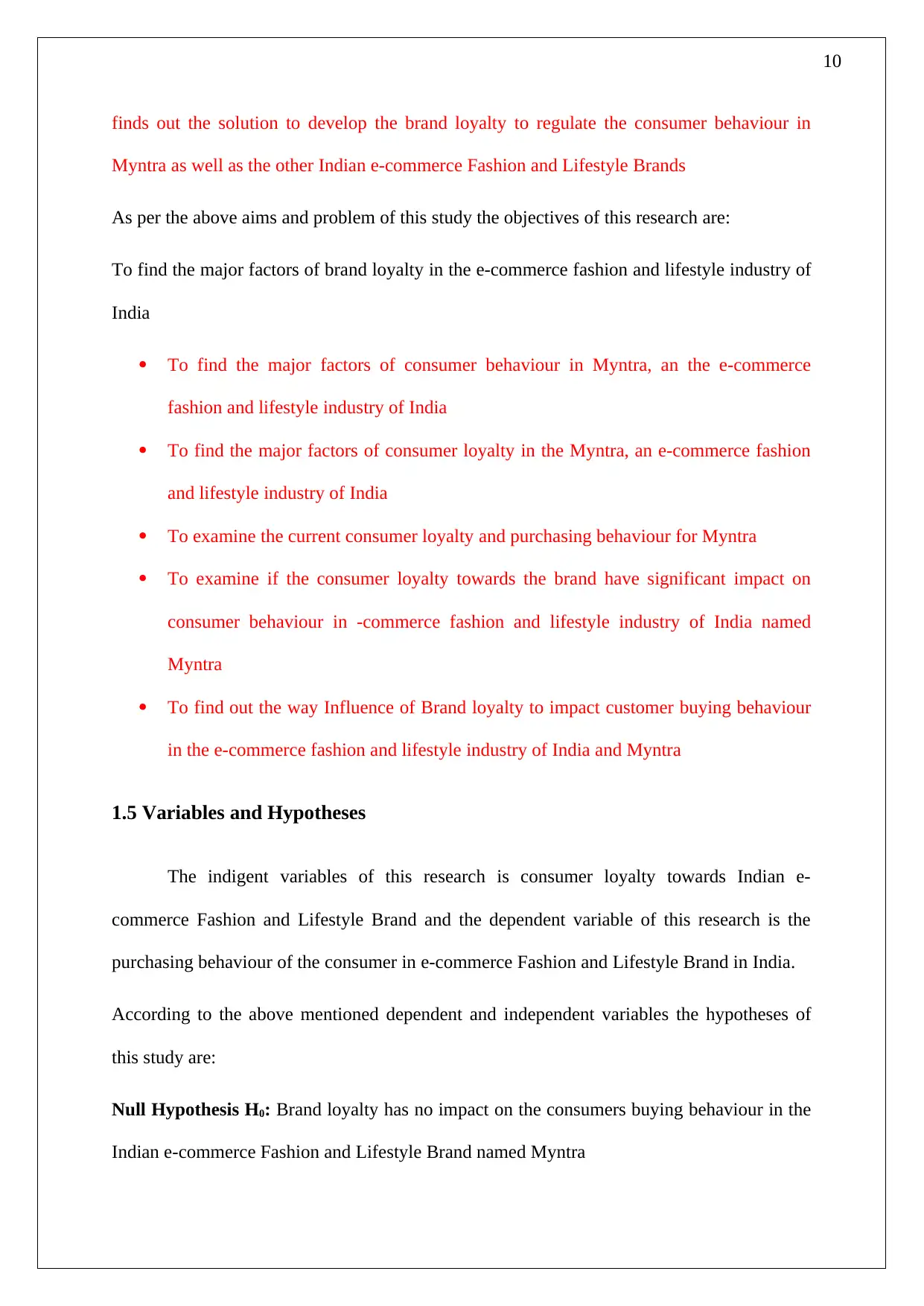
10
finds out the solution to develop the brand loyalty to regulate the consumer behaviour in
Myntra as well as the other Indian e-commerce Fashion and Lifestyle Brands
As per the above aims and problem of this study the objectives of this research are:
To find the major factors of brand loyalty in the e-commerce fashion and lifestyle industry of
India
To find the major factors of consumer behaviour in Myntra, an the e-commerce
fashion and lifestyle industry of India
To find the major factors of consumer loyalty in the Myntra, an e-commerce fashion
and lifestyle industry of India
To examine the current consumer loyalty and purchasing behaviour for Myntra
To examine if the consumer loyalty towards the brand have significant impact on
consumer behaviour in -commerce fashion and lifestyle industry of India named
Myntra
To find out the way Influence of Brand loyalty to impact customer buying behaviour
in the e-commerce fashion and lifestyle industry of India and Myntra
1.5 Variables and Hypotheses
The indigent variables of this research is consumer loyalty towards Indian e-
commerce Fashion and Lifestyle Brand and the dependent variable of this research is the
purchasing behaviour of the consumer in e-commerce Fashion and Lifestyle Brand in India.
According to the above mentioned dependent and independent variables the hypotheses of
this study are:
Null Hypothesis H0: Brand loyalty has no impact on the consumers buying behaviour in the
Indian e-commerce Fashion and Lifestyle Brand named Myntra
finds out the solution to develop the brand loyalty to regulate the consumer behaviour in
Myntra as well as the other Indian e-commerce Fashion and Lifestyle Brands
As per the above aims and problem of this study the objectives of this research are:
To find the major factors of brand loyalty in the e-commerce fashion and lifestyle industry of
India
To find the major factors of consumer behaviour in Myntra, an the e-commerce
fashion and lifestyle industry of India
To find the major factors of consumer loyalty in the Myntra, an e-commerce fashion
and lifestyle industry of India
To examine the current consumer loyalty and purchasing behaviour for Myntra
To examine if the consumer loyalty towards the brand have significant impact on
consumer behaviour in -commerce fashion and lifestyle industry of India named
Myntra
To find out the way Influence of Brand loyalty to impact customer buying behaviour
in the e-commerce fashion and lifestyle industry of India and Myntra
1.5 Variables and Hypotheses
The indigent variables of this research is consumer loyalty towards Indian e-
commerce Fashion and Lifestyle Brand and the dependent variable of this research is the
purchasing behaviour of the consumer in e-commerce Fashion and Lifestyle Brand in India.
According to the above mentioned dependent and independent variables the hypotheses of
this study are:
Null Hypothesis H0: Brand loyalty has no impact on the consumers buying behaviour in the
Indian e-commerce Fashion and Lifestyle Brand named Myntra
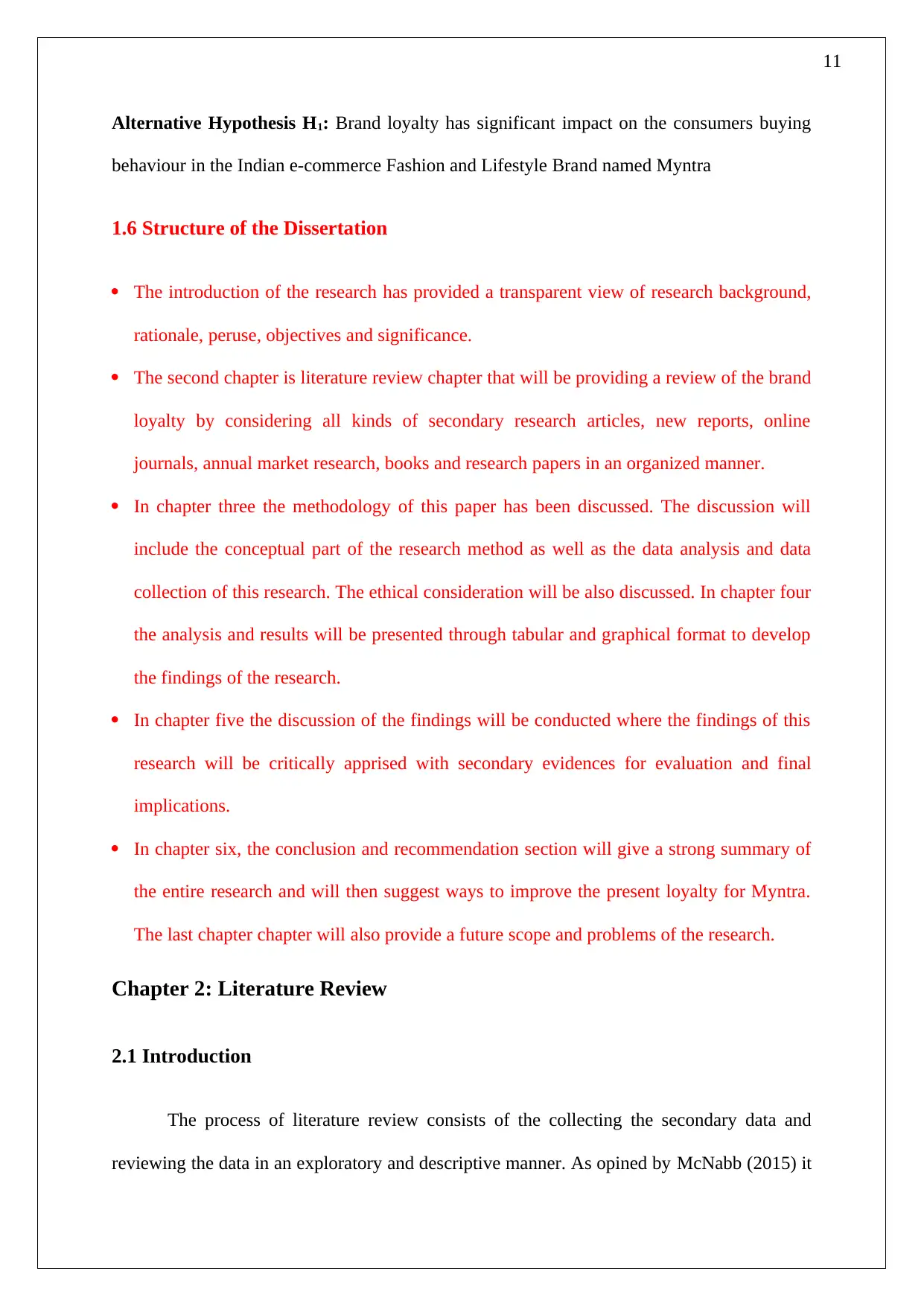
11
Alternative Hypothesis H1: Brand loyalty has significant impact on the consumers buying
behaviour in the Indian e-commerce Fashion and Lifestyle Brand named Myntra
1.6 Structure of the Dissertation
The introduction of the research has provided a transparent view of research background,
rationale, peruse, objectives and significance.
The second chapter is literature review chapter that will be providing a review of the brand
loyalty by considering all kinds of secondary research articles, new reports, online
journals, annual market research, books and research papers in an organized manner.
In chapter three the methodology of this paper has been discussed. The discussion will
include the conceptual part of the research method as well as the data analysis and data
collection of this research. The ethical consideration will be also discussed. In chapter four
the analysis and results will be presented through tabular and graphical format to develop
the findings of the research.
In chapter five the discussion of the findings will be conducted where the findings of this
research will be critically apprised with secondary evidences for evaluation and final
implications.
In chapter six, the conclusion and recommendation section will give a strong summary of
the entire research and will then suggest ways to improve the present loyalty for Myntra.
The last chapter chapter will also provide a future scope and problems of the research.
Chapter 2: Literature Review
2.1 Introduction
The process of literature review consists of the collecting the secondary data and
reviewing the data in an exploratory and descriptive manner. As opined by McNabb (2015) it
Alternative Hypothesis H1: Brand loyalty has significant impact on the consumers buying
behaviour in the Indian e-commerce Fashion and Lifestyle Brand named Myntra
1.6 Structure of the Dissertation
The introduction of the research has provided a transparent view of research background,
rationale, peruse, objectives and significance.
The second chapter is literature review chapter that will be providing a review of the brand
loyalty by considering all kinds of secondary research articles, new reports, online
journals, annual market research, books and research papers in an organized manner.
In chapter three the methodology of this paper has been discussed. The discussion will
include the conceptual part of the research method as well as the data analysis and data
collection of this research. The ethical consideration will be also discussed. In chapter four
the analysis and results will be presented through tabular and graphical format to develop
the findings of the research.
In chapter five the discussion of the findings will be conducted where the findings of this
research will be critically apprised with secondary evidences for evaluation and final
implications.
In chapter six, the conclusion and recommendation section will give a strong summary of
the entire research and will then suggest ways to improve the present loyalty for Myntra.
The last chapter chapter will also provide a future scope and problems of the research.
Chapter 2: Literature Review
2.1 Introduction
The process of literature review consists of the collecting the secondary data and
reviewing the data in an exploratory and descriptive manner. As opined by McNabb (2015) it
⊘ This is a preview!⊘
Do you want full access?
Subscribe today to unlock all pages.

Trusted by 1+ million students worldwide
1 out of 63
Related Documents
Your All-in-One AI-Powered Toolkit for Academic Success.
+13062052269
info@desklib.com
Available 24*7 on WhatsApp / Email
![[object Object]](/_next/static/media/star-bottom.7253800d.svg)
Unlock your academic potential
Copyright © 2020–2025 A2Z Services. All Rights Reserved. Developed and managed by ZUCOL.





